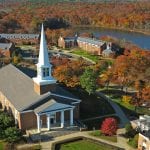May 1 is the national deposit deadline for colleges and universities. This is the day when students make their final college enrollment decision and provide a financial deposit to the school of their choice. Across the country, hundreds of thousands of students are trying to figure out where to spend the next four years. They’ll seek guidance from friends and family. They’ll read books and listen to podcasts. Many will pray. But to be frank, most of them are clueless about the most important factor they should be considering—the hidden curriculum of an institution.
Every higher education institution has one. It’s not the catchy slogan emblazoned on campus merchandise, and it’s not necessarily in an admissions counselor’s spiel. It’s the subtle lessons we learn about an institution through studying their campus programs, student activities, and the institutional funding allocated for programming beyond the classroom. You don’t need a PhD to discern an institution’s hidden curriculum. It only requires a curious mind, a discerning heart, and knowing where to look.
One of the best ways to get a sense of an institution’s hidden curriculum is to spend time on a campus. Look around and study the place. What campus events are advertised? How do students treat one another and the faculty? What is reported in the campus newspaper? Facilities are another good indicator of an institution’s hidden curriculum. If you are interested in studying theater, but the institution hasn’t made an investment in the arts in years, it might be a sign you’re looking in the wrong place. If you want to grow in your faith at college, but the institution is hostile toward Christian groups, you might be heading to the wrong institution.
At a well-regarded higher education institution I know, there is an infamous event referred to as “the night of decadence.” On this night, the campus turns a blind eye to underage drinking, and a host of other things, and lets students do as they desire for one night. This night is a piece of the school’s hidden curriculum. And nights like it are part of the hidden curriculum at institutions around the world. As much as believers strive to be in the world but not of the world, attending an institution where the hidden curriculum contradicts your own core convictions takes a heavy toll—and it’s a toll many 18-year-olds are simply not ready to face.
College Shapes You
I frequently hear from students who are excited to attend an institution they recognize as counter to their own beliefs, because they believe that they will positively change the institution or their peers. But the reality is you’re much more likely to be shaped by the institutions you join than you are to shape those institutions. The hidden curriculum of an institution shapes young people’s desires for life and for what their life will become. The incredible privilege, responsibility, and draw of working in higher education is that our actions will have a lasting effect on the people who come to study at our institutions.
Christian institutions like to use the language of “vocation,” which theologian Frederick Buechner describes as “where your deep gladness and the world’s deep hunger meet.” But our heart’s “deep gladness” is shaped by the people who surround us, by the mentors and exemplars we emulate, by the teachers who introduce us to new ideas and new possibilities. This is why one’s college choice is so important.
Most of higher education is deeply committed to shaping young people—shaping their imagination of what counts for “social justice,” motivating them about what to protest and what to promote. Most parents are oblivious to this commitment, but it’s among the biggest factors that will shape the hearts and minds of young people who are deciding this week where they will go. After 18 years of careful parenting, you eventually need to turn your student over to an institution hoping they will come back whole. To send them away without understanding the hidden curriculum of an institution would be a shame.
Higher education isn’t only about what you learn academically, but also about gathering the skills to decide what to do with what you know. It’s about bridging subjects as diverse as physics and visual arts, about dorm living and building community and connecting work life with personal life. The formative conversations made possible through an intentional institution with a deeper hidden curriculum becomes a defining feature of a transformative college experience. It provides the framework for the exploration of vocation with the hope of propelling the student to succeed after four years into “real life.” It’s why I left a secular institution and came to Gordon College. I wanted to advance a “hidden curriculum” I could believe in.
Intentional Hidden Curriculum
At a Christian liberal arts college, there is intentionality in the hidden curriculum that lies at the core of everything we do: we believe that all truth is God’s truth, that we must embody virtue in our community in order to develop it in our students, and that it’s possible to shape both the hearts and also the minds of a generation while also shaping their souls for godly good. We exemplify this in weaving together these truths in everything we do.
In our best moments, the hidden curriculum at Christian institutions is not hidden, but lived intentionally in a community with one another. As Dietrich Bonhoeffer wrote in Life Together:
The more genuine and the deeper our community becomes, the more will everything else between us recede, the more clearly and purely will Jesus Christ and his work become the one and only thing that is vital between us. We have one another only through Christ, but through Christ we do have one another, wholly, for eternity.
That’s what we are trying to do in Christian schools and universities. It’s not the only viable choice, to be sure, but it’s a wise choice for thousands of families.
So when you visit a college campus, learn about its mission. Meet the students. Talk to the faculty. Look around intently. Their mission, their curriculum, should be lived out evidently. Then ask yourself, Is this a place worth spending the most important years of my life?
Is there enough evidence for us to believe the Gospels?
 In an age of faith deconstruction and skepticism about the Bible’s authority, it’s common to hear claims that the Gospels are unreliable propaganda. And if the Gospels are shown to be historically unreliable, the whole foundation of Christianity begins to crumble.
In an age of faith deconstruction and skepticism about the Bible’s authority, it’s common to hear claims that the Gospels are unreliable propaganda. And if the Gospels are shown to be historically unreliable, the whole foundation of Christianity begins to crumble.


































